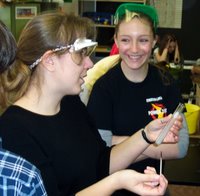Search Strategies - More than "Just Google It"
Every year, I ask my 6th grade students to respond to the following prompt in their Tech journals: "Describe your strategies for researching using the Internet." Without fail, at least 80% of them will respond with something like, "I type a word into Google and then click on the first website listed" or "I go straight to Wikipedia."
So, I think it time to teach Internet search strategies a little more explicitly. (Even the New York Times recently posted a lesson plan for dealing with Internet searching skills.)
These are the search strategies I start with for my students when they begin their projects:
So, I think it time to teach Internet search strategies a little more explicitly. (Even the New York Times recently posted a lesson plan for dealing with Internet searching skills.)
These are the search strategies I start with for my students when they begin their projects:
- Take note of the domain names types (.gov & .edu tend to have most "reliable" info)
- Check the "About Us" to see if the site is reliable.
- Try searching -.com or +.edu. (ex: Twitter -.com)
- Try putting your search item in quotes. (ex: "history of Mt. Vesuvius" instead of just history of Mt. Vesuvius)
- Try subtracting or add words (for example type 'Tiger -Woods' to search for info on the animal.)
- Try clicking on the little superscript numbers in Wikipedia to find out the source that is used.
- Try searching popular news places - (Newsweek, Time, New York Times, Gizmodo, TechCrunch, Crunchbase (wiki)) (ex: "Yelp +Chicago Tribune")
- Use other media, such as videos (TED talks, YouTube interviews)or podcasts (KQED, NPR)
And, don't forget when you are searching to cite the websites you use!
Labels: media literacy, teaching
